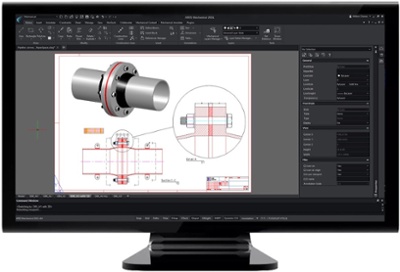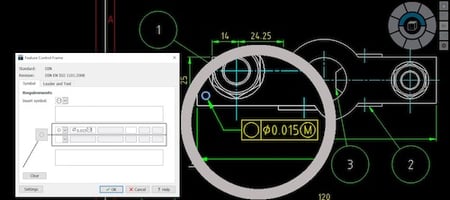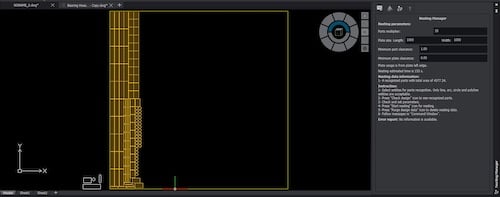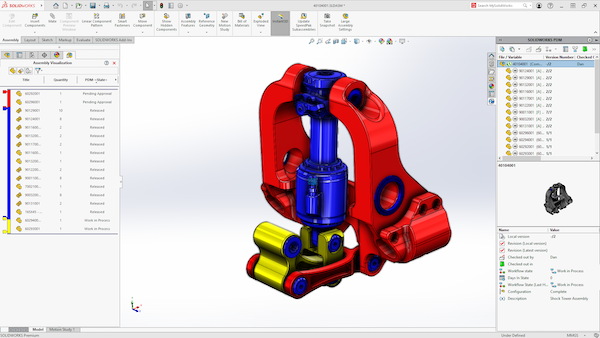ARES Mechanical has been an affordable and reliable mechanical CAD program since it was introduced in 2017. It provides a variety of features specific to mechanical drafting for the universe of users working in the DWG format.
It also offers unrivaled flexibility in terms of licensing, letting users choose among Perpetual, Term, and Network licenses. (AutoCAD with Mechanical Toolsets, in contrast, is only available as a subscription; you can read more about that at the end of this article).

ARES Mechanical is able to edit mechanical drawings created with AutoCAD Mechanical. Click image to enlarge.
In April 2023, Graebert will launch ARES Mechanical 2024, which extends this comprehensive mechanical toolset with a host of new features that improve workflows for some of the most tedious tasks in mechanical drafting. Read on for an introduction to these features and their potential impacts on your workflows.
And for more insights on this subject, be sure to join the free 30-minute webinar I will be offering on April 13, 2023, at the Graebert neXt event.
Compatibility with AutoCAD Mechanical Drawings
Before we dive into the new features, I’ll give you a quick overview of the software and its core capabilities for creating and modifying 2D mechanical drawings, including those that were originally created with AutoCAD Mechanical.
ARES Mechanical's user interface will be familiar to AutoCAD users. Click image to enlarge.
ARES Mechanical offers a user interface familiar to AutoCAD users, and full compatibility with the DWG drawing format. It also supports the STEP and IGES formats for interoperability. The software is fully equipped for mechanical drafting, with drawing and editing tools customized for the purpose, a library of standard parts, and a standards-based set of mechanical layers. And it supports a range of widely used mechanical standards — including ISO, ANSI, DIN, JIS, and BSI.
Last year, Graebert achieved a major development goal: adding support for mechanical entities created in AutoCAD Mechanical. In addition to the geometry visible in the drawing, the mechanical entities convey rich information about the standard parts used (aka part references or part refs), which are also employed in creating part lists and BOMs (bill of materials).
Although these mechanical entities (or “smart objects”) are useful, they are not standard to the common DWG format. This means they were unusable in any DWG-based CAD software other than AutoCAD Mechanical — they didn’t even function in AutoCAD itself without the Mechanical Toolset.
But, that changed when Graebert solved this key problem for the mechanical CAD community. (For more background on how Graebert addressed this issue, refer to my article from 2022, “ARES Mechanical Introduces Support for AutoCAD Mechanical Entities.”)
Now, it is no longer necessary to rely on only one software product to open, use, and update important legacy drawings. Current and former AutoCAD Mechanical users often have thousands — if not hundreds of thousands — of drawings that were created in that program. ARES Mechanical offers these users an affordable way to continue working with such drawings, plus the support of a company committed to constant improvement.
New ARES Mechanical Features in Version 2024
The new features coming to ARES Mechanical extend the product’s ability to edit drawings created in AutoCAD Mechanical, with new tools for detailing and annotation. There are also new tools for creating and editing part features, including geometric dimensioning and tolerancing (GD&T). A new layer enhancement feature helps organize items with similar properties. A new BOM Manager streamlines many tasks related to creating and using the bill of materials. And finally, the new Nesting Manager brings a level of automation to part nesting not found in any other mechanical drafting program.
Detail Annotation. The AMDETAIL command enlarges and annotates areas that cannot be displayed or dimensioned clearly in the drawing. Users can create a detailed view of a specified area in model space, in a layout, or in both. In layout, the detail can be represented as a zoomed viewport with a predefined scale.
Especially important, AMDETAIL also edits detail views created by AutoCAD Mechanical. Users can modify the detail view styles for text and symbols, boundary line, and label contents in the dialog box.
Feature Control Frame. The Feature Control Frame command, AM_FCFRAME, describes the conditions and tolerances of a geometric control on a part feature. This command brings increased automation to GD&T drafting, a notoriously complicated part of detailing drawings.
The Feature Control Frame. Click image to enlarge.
The Feature Control Frame includes four elements: GD&T symbol/control symbol; tolerance zone type and dimensions; tolerance zone modifiers such as features of size; and datum references (if required by the GD&T symbol).
Layer Visibility Enhancement. The Layer Visibility Enhancement command simplifies the process of turning items with similar properties into their own groups on their own layers. The user specifies how objects on inactive layer groups appear in the drawing area during a drawing session. The AMLAYVISENH command displays the Layer Visibility Enhancement dialog, where users can choose such options as locking layer groups and changing the colors of objects on certain layer groups.
Better BOM Creation. The bill of materials (BOM) is a critical component of any mechanical drawing, providing a detailed list of all the parts and components required to manufacture a product. In the 2024 release of ARES Mechanical, the BOM command has been significantly enhanced to provide increased functionality and improved ease of use.
ARES Mechanical users may now export and import BOM CSV files. This makes it possible to share BOM data with other team members or external stakeholders, streamlining the manufacturing process and reducing the risk of errors or miscommunications.
Another enhancement is the ability to create a part reference from the BOM items list for a user-defined item. This new feature makes it easy to add custom parts or components to the BOM, allowing users to create highly detailed and accurate bills of materials.
When a new part reference is added to a BOM, properties are filled in automatically. This means users can amend an existing BOM with new information, instead of having to start over and generate an all-new BOM. Columns can be reorganized and continually synchronized to the BOM as created. All aspects of a BOM may be edited within the BOM Settings dialog, allowing drafters to customize most aspects.
Additionally, users can now attach the BOM of another drawing to the selected part reference, making it easy to reuse BOM data across multiple projects or drawings. This feature can significantly reduce the amount of time required to create new drawings, enabling drafting teams to work more efficiently and effectively.
ARES Mechanical 2024 also includes new capabilities for creating part lists from the BOM dialog; creating balloons from the BOM dialog; zooming and highlighting items on the BOM; and adding columns and rows to the BOM table. These enhancements give users better control over their BOM data, making it easier to create detailed and accurate mechanical drawings.
Being able to zoom inside the BOM essentially makes the BOM a navigation device, taking the drafter directly to the part of interest. The user can work interactively, editing both BOM and drawing elements as needed.
More Control over BOM Settings. Users can access the BOM settings with the command AM_BOMSETTINGS. This is a feature for mechanical drawings compatible with AutoCAD Mechanical. BOM settings enable users to set the properties of the BOM, part lists, and balloons.
ARES Mechanical's BOM Settings dialog box. Click image to enlarge.
In the BOM Settings dialog, users may perform actions including, but not limited to, displaying component properties and setting them to be visible for part references and part lists. Further operations are available in the Component Properties, BOM, Parts List, and Balloon tabs within this dialog.
Automated Part Nesting. Preparing a drawing to drive metal cutting is a completely manual process in most shops, but ARES Mechanical 2024 offers a better method: Nesting Manager. No other 2D CAD drafting tool for mechanical design offers an equivalent to the automation found in ARES Mechanical Nesting Manager.
The Nesting Manager plugin. Click image to enlarge.
In use, this tool minimizes the amount of scrap (residual raw material) produced during cutting. The Nesting Manager plugin works with single or multiple parts, and it allows users to set parameters for nesting such as plate size and minimum clearances for part and plate. Once given the inputs, the tool returns the best possible nesting results.
The Final Analysis
In version 2024, Graebert is taking ARES Mechanical — which was already a comprehensive, cost-saving CAD solution capable of replacing AutoCAD Mechanical — to a new level. Overall, the enhancements in ARES Mechanical 2024 represent a substantial improvement when working in the tedious and repetitive aspects of mechanical drafting. And with significant innovations such as the Nesting Manager, Graebert continues to set the standard for mechanical drafting software.
And as if the technical features were not enough, Graebert offers more than one way to buy and use ARES Mechanical, giving customers multiple options to accommodate their workflows and budgets. The standalone product is available as a single or Flex/Network perpetual license; the Trinity version (which includes ARES Touch and ARES Kudo) is available as an annual, three-year, or perpetual license, in addition to the new Flex Cloud license to share licenses even when users are not in a same location.
This flexibility is starkly different from Autodesk’s licensing approach; the only option to use AutoCAD Mechanical toolsets is an annual subscription that costs $1,895 in the U.S. (Prices for ARES Mechanical, in contrast, start at $450 for 1 year.) In past years, many Autodesk customers reduced their software expenditures by leveraging multi-user or “network” licenses that allowed two or more users to share one license. But since Autodesk has stopped offering or renewing such network licenses in favor of “named-user licenses,” costs have increased dramatically for these companies. Now, even those employees who only use 2D occasionally need their own AutoCAD Mechanical licenses.
To take an in-depth look at ARES Mechanical, I invite you to join my 30-minute keynote during the free, online Graebert neXt event in April. You will learn more about the software and the new features in version 2024 — and see how they can improve your workflows.
Randall S. Newton
Randall S. Newton Managing Director of Consilia Vektor, is an analyst and journalist focused on technologies for design, construction, engineering, and blockchain. He is also an Associate at Wohlers Associates powered by ASTM International.
View All Articles









Searching for more information about Product Design & Manufacturing?
Click here!